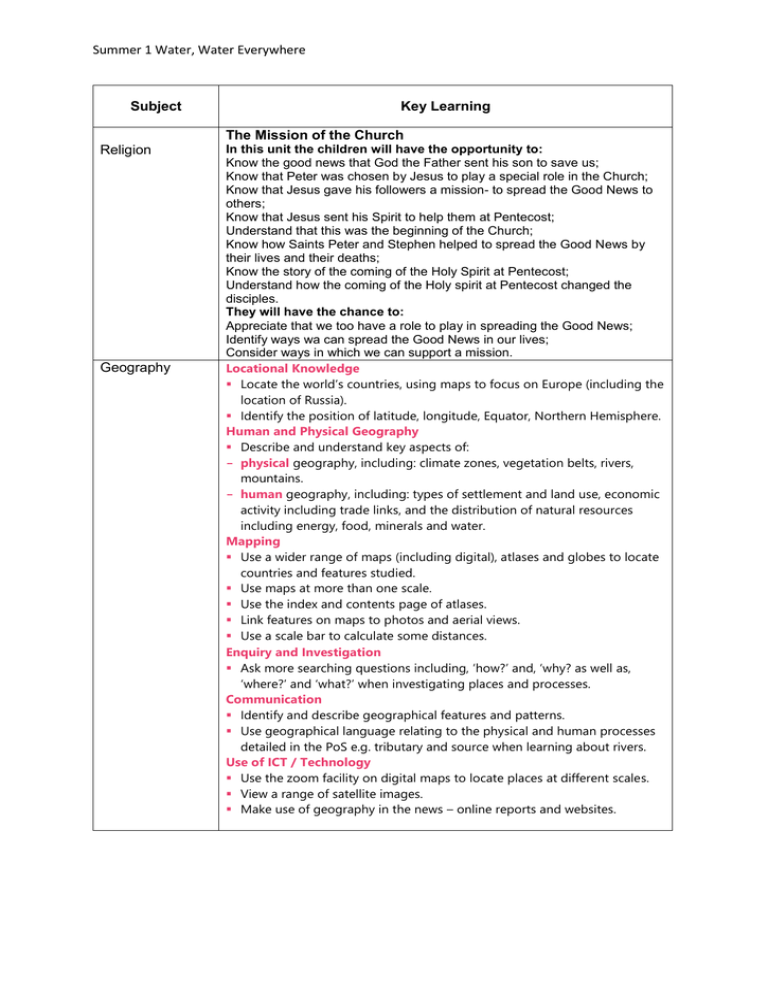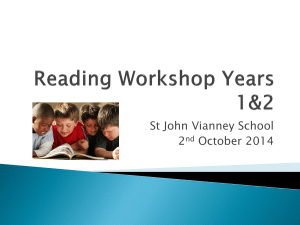Key Learning Summer 1 : file
advertisement

Summer 1 Water, Water Everywhere Subject Key Learning The Mission of the Church Religion Geography In this unit the children will have the opportunity to: Know the good news that God the Father sent his son to save us; Know that Peter was chosen by Jesus to play a special role in the Church; Know that Jesus gave his followers a mission- to spread the Good News to others; Know that Jesus sent his Spirit to help them at Pentecost; Understand that this was the beginning of the Church; Know how Saints Peter and Stephen helped to spread the Good News by their lives and their deaths; Know the story of the coming of the Holy Spirit at Pentecost; Understand how the coming of the Holy spirit at Pentecost changed the disciples. They will have the chance to: Appreciate that we too have a role to play in spreading the Good News; Identify ways wa can spread the Good News in our lives; Consider ways in which we can support a mission. Locational Knowledge Locate the world’s countries, using maps to focus on Europe (including the location of Russia). Identify the position of latitude, longitude, Equator, Northern Hemisphere. Human and Physical Geography Describe and understand key aspects of: - physical geography, including: climate zones, vegetation belts, rivers, mountains. - human geography, including: types of settlement and land use, economic activity including trade links, and the distribution of natural resources including energy, food, minerals and water. Mapping Use a wider range of maps (including digital), atlases and globes to locate countries and features studied. Use maps at more than one scale. Use the index and contents page of atlases. Link features on maps to photos and aerial views. Use a scale bar to calculate some distances. Enquiry and Investigation Ask more searching questions including, ‘how?’ and, ‘why? as well as, ‘where?’ and ‘what?’ when investigating places and processes. Communication Identify and describe geographical features and patterns. Use geographical language relating to the physical and human processes detailed in the PoS e.g. tributary and source when learning about rivers. Use of ICT / Technology Use the zoom facility on digital maps to locate places at different scales. View a range of satellite images. Make use of geography in the news – online reports and websites. Summer 1 Water, Water Everywhere Science (Two units over the half term) Material Properties and Changes - States of Matter Compare and group materials together, according to whether they are solids, liquids or gases. Solids, liquids and gases can be identified by their observable properties. Solids have a fixed size and shape (the size and shape can be changed but it remains the same after the action). Liquids can pour and take the shape of the container in which they are put. Liquids form a pool not a pile. Solids in the form of powders can pour as if they were liquids but make a pile not a pool. Gases fill the container in which they are put. Gases escape from an unsealed container. Gases can be made smaller by squeezing/pressure. Liquids and gases can flow. Pupils Might Work Scientifically By grouping and classifying a variety of different materials. By exploring the effect of temperature on water and ice. By researching the temperature at which materials change state, for example, when iron melts or when oxygen condenses into a liquid. By observing and recording evaporation over a period of time, such as a puddle in the playground or washing on a line. By investigating the effect of temperature on washing drying or snowmen melting. Sound Identify how sounds are made, associating some of them with something vibrating. Recognise that vibrations from sounds travel through a medium to the ear. Find patterns between the volume of a sound and the strength of the vibrations that produced it. Recognise that sounds get fainter as the distance from the sound source increases. Sounds can be made in a variety of ways (pluck, bang, shake, blow) using a variety of things (instruments, everyday materials, body). Sounds travel away from their source in all directions. Vibrations may not always be visible to the naked eye. Pitch Find patterns between the pitch of a sound and features of the object that produced it. Sounds can be high or low pitched. The pitch of a sound can be altered. Pitch can be altered either by changing the material, tension, thickness or length of vibrating objects or changing the length of a vibrating air column. Muffling/blocking sounds Recognise that vibrations from sounds travel through a medium to the ear. Sounds are heard when they enter our ears (although the structure of the ear is not important key learning at this age phase). Sounds can travel through solids, liquids and air/gas by making the materials vibrate. Sound travel can be reduced by changing the material that the vibrations travel through. Sound travel can be blocked. Pupils might work scientifically by: Finding patterns in the sounds that are made by different objects such as saucepan lids of different sizes or elastic bands of different thicknesses. They might make ear muffs from a variety of different materials to investigate which provides the best insulation against sound. They could make and play their own instruments by using what they have found out about pitch and volume. Summer 1 Water, Water Everywhere Computing PE Athletics PE Striking and Fielding- Cricket Sound Skills Use a variety of devices and software to select, playback and record voice and other sounds. Locate and use sound files from online sources, e.g. Audio Networks, and other multimedia resources Select, import and edit existing sound files in sound editing software, e.g. Audacity. Use editing tools to refine and improve outcomes and performances. Use recorded sound files in other software applications. Be able to share sound recordings with a wider audience. Use music software to experiment with capturing, repeating and sequencing sound patterns. Use ICT to create and perform sounds or music that would otherwise not be possible in a live situation, e.g. editing a multi-part piece. Knowledge and Understanding Talk about software which allows the creation and manipulation of sound and music. Understand that many types of sounds can be combined in editing software. Understand how sound can be used in multimodal texts to create meaning and provide effects. Understand that copyright exists on most recorded music. Online Safety Skills Use technology responsibly. Recognise acceptable behaviour. Recognise unacceptable behaviour. Knowledge and Understanding Understand the risks posed by the internet relating to contact e.g. bullying, grooming. Know a range of ways to report concerns about contact. Know a range of ways to report concerns about content. Understand what acceptable online behaviour is. Understand what unacceptable online behaviour is. tional Curriculum Links use running, jumping, throwing and catching in isolation and in combination develop flexibility, strength, technique, control and balance [for example, through athletics and gymnastics] take part in outdoor and adventurous activity challenges both individually and within a team compare their performances with previous ones and demonstrate improvement to achieve their personal best. use running, jumping, throwing and catching in isolation and in combination play competitive games, modified where appropriate [for example, badminton, basketball, cricket, football, hockey, netball, rounders and tennis], and apply basic principles suitable for attacking and defending take part in outdoor and adventurous activity challenges both individually and within a team compare their performances with previous ones and Summer 1 Water, Water Everywhere demonstrate improvement to achieve their personal best.





